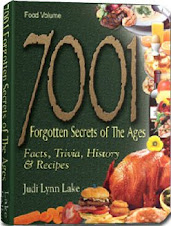
As in every trade, the master tradesman has his or her secrets that set them apart from everyone else. Learning the basics will get the job done, but learning the secrets of the trade gets the job done effortlessly and often times better. Seldom can we pry these secrets from the masters. They are usually passed down to a favorite apprentice upon retirement, or subliminally slipped to them, kind of like the coming-of-age thing.
But as with all good secrets, some just leak out and the wary ear takes note. This knowledge is a wonderful tool. It allows us to expand our horizons, broaden our own expectations, and many times dazzles our counterparts and peers. It is the feeling of pride you get lifting the holiday meal from the oven, the aroma drifting from room to room, and the contented faces of your guests at meal’s end.
Knowledge is the weapon that turns so many ingredients into that succulent meal or dessert. Adding a dash of this and a dash of that at just the right time, at just the right temperature, can make the difference and turn that same old turkey dinner into a holiday feast. It is that one secret ingredient you added to your dessert that made it not just good, but outstanding.
Wandering down this path of taste-tempting delights, keep a wary ear to the ground. There is no telling what secrets will slip. It is no matter what culinary path you choose to follow—baking or BBQing, burgers or soufflés—there are always secrets ‘round the corner. You may even develop a few of your own to pass along. Grandmothers are a tremendous source of culinary secrets that have teased the palates of families for generations.
Some Chef’s Quick Tips:
• Easily peel tomatoes by first putting them in boiling water then removing them again immediately. Let stand for 1 minute, then quickly put them in cold water.
• "The Royal French Fry" Want great gourmet French fries? Here is the secret. Allow crinkle-cut potatoes to stand in ice cold water, in the refrigerator for 1 hour before frying. This hardens the fries so they do not absorb as much fat during frying. Dry thoroughly before frying. Then fry them two times. Fry them for only a few minutes the first time. Then dry them well, dust them with a small amount of flour and fry them until they are a luscious golden brown.
• Tired of waiting for that baked potato? Potatoes bake faster and the skins do not crack if you oil or rub the skin with butter rather than wrapping in tin foil. You can also insert an aluminum nail in them, which will also speed the cooking time by 15 minutes. For one of the fastest ways, just boil them for 10 minutes and then place them into the oven.
• Both onions and potatoes have a tendency to give off natural gases. That is why you should never store them together. The potatoes become soft and rot.
• Want some sexy potatoes? Potatoes loved to be stored in pantyhose. All you do is cut a leg off a pair of pantyhose, drop the spud in, then hang it up in a cool, dry place.
• Here is a way to add a little zest to your stir-fried vegetables or salads. Just add some radish leaves; they are not as spicy as the radish itself.
• Beat egg whites in a way to always trap the most amount of air. Do not over-beat or they become dry and can cause a collapse.
• Want easy to peel hard-boiled eggs? Just add salt to water when boiling.
• Create great deviled eggs. Keep the yolks centered by stirring the water while cooking the eggs.
• Did you know that you can use cottage cheese in place of sour cream for making dips? Just blend it in the blender until it is creamed.
• Cottage cheese lasts longer when stored upside down. When you open cottage cheese, spores enter from the air and live on the oxygen layer in the container. Turning it upside down allows it to fall to the top, eliminating a percentage of the oxygen layer. Spores do not grow as fast, and the cottage cheese can last 7-10 days longer.
• Add sour cream to hot recipes just before serving. If you need to reheat a dish containing sour cream, reheat it slowly so the sour cream does not separate.
• The best way to cut cheese is with a dull knife, especially if you warm the blade first.
• After flouring a chicken, chill it for 1 hour so the coating will adhere better during frying.
• All poultry should be cooked to a center temperature of 185 degrees F.
###
The following video, Chef To Chef, courtesy of You Tube.
###





 Stumble It!
Stumble It!


No comments:
Post a Comment